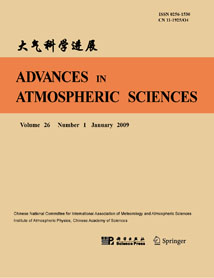| [1] |
S. K. Sinha, D. R. Talwalkar, S. Rajamani,
1987: ON SOME ASPECTS OF OBJECTIVE ANALYSIS OF HUMI-DITY OVER INDIAN REGION BY THE OPTIMUM INTERPOLATION METHOD, ADVANCES IN ATMOSPHERIC SCIENCES, 4, 332-342.
doi: 10.1007/BF02663603
|
| [2] |
S.K. Sinha, D.R. Talwalkar, S.G. Narkhedkar, S. Rajamani,
1989: A Scheme for Objective Analysis of Wind Field Incorporating Multi-Weighting Functions in the Optimum Interpolation Method, ADVANCES IN ATMOSPHERIC SCIENCES, 6, 435-446.
doi: 10.1007/BF03342547
|
| [3] |
S.K. Sinha, S. Rajamani,
1995: Multivariate Objective Analysis of Wind and Height Fields in the Tropics, ADVANCES IN ATMOSPHERIC SCIENCES, 12, 233-244.
doi: 10.1007/BF02656836
|
| [4] |
P. N. Mahajan, D. R. Talwalkar, S. Nair, S. Rajamani,
1992: Construction of Vertical Wind Profile from Satellite-Derived Winds for Objective Analysis of Wind Field, ADVANCES IN ATMOSPHERIC SCIENCES, 9, 237-246.
doi: 10.1007/BF02657514
|
| [5] |
M. Y. Totagi, D. R. Talwalkar, S. Rajamani, S. S. Singh,
1992: Analysis-Prediction Experiments over Indian Region Using Primitive Equation Barotropic Model, ADVANCES IN ATMOSPHERIC SCIENCES, 9, 477-482.
doi: 10.1007/BF02677080
|
| [6] |
S. N. Bavadekar, R. M. Khaladkar,
1994: Estimation of Winds at Different Isobaric Levels Based on the Observed Winds at 850 hPa Level Using Double Fourier Series, ADVANCES IN ATMOSPHERIC SCIENCES, 11, 327-334.
doi: 10.1007/BF02658152
|
| [7] |
XU Dongmei, Thomas AULIGNÈ, Xiang-Yu HUANG,
2015: A Validation of the Multivariate and Minimum Residual Method for Cloud Retrieval Using Radiance from Multiple Satellites, ADVANCES IN ATMOSPHERIC SCIENCES, 32, 349-362.
doi: 10.1007/s00376-014-3258-5
|
| [8] |
ZHAO Jun, SONG Junqiang, LI Zhenjun,
2003: Distributed Parallelization of a Global Atmospheric Data Objective Analysis System, ADVANCES IN ATMOSPHERIC SCIENCES, 20, 159-163.
doi: 10.1007/BF03342060
|
| [9] |
Joon Jin SONG, Soohyun KWON, GyuWon LEE,
2015: Incorporation of Parameter Uncertainty into Spatial Interpolation Using Bayesian Trans-Gaussian Kriging, ADVANCES IN ATMOSPHERIC SCIENCES, 32, 413-423.
doi: 10.1007/s00376-014-4040-4
|
| [10] |
WANG Hesong, JIA Gensuo,
2013: Regional Estimates of Evapotranspiration over Northern China Using a Remote-sensing-based Triangle Interpolation Method, ADVANCES IN ATMOSPHERIC SCIENCES, 30, 1479-1490.
doi: 10.1007/s00376-013-2294-x
|
| [11] |
S. K. Sinha, D, R. Talwalkar, S. G. Narkhedkar, P. L. Kulkarni, S. Nair, S. Rajamani,
1990: Use of Surface Observations to Estimate Upper Air Humidity for the Objective Analysis of Relative Humidity over Indian Region, ADVANCES IN ATMOSPHERIC SCIENCES, 7, 491-501.
doi: 10.1007/BF03342567
|
| [12] |
N. R. Parija, S. K. Dash,
1995: Some Aspects of the Characteristics of Monsoon Disturbances Using a Combined Barotropic-Baroclinic Model, ADVANCES IN ATMOSPHERIC SCIENCES, 12, 487-506.
doi: 10.1007/BF02657007
|
| [13] |
Yang LU, Xiaochun WANG, Jihai DONG,
2021: Melt Pond Scheme Parameter Estimation Using an Adjoint Model, ADVANCES IN ATMOSPHERIC SCIENCES, 38, 1525-1536.
doi: 10.1007/s00376-021-0305-x
|
| [14] |
YAO Zhigang, LIN Longfu, CHEN Hongbin, FEI Jianfang,
2008: A Scheme for Estimating Tropical Cyclone Intensity Using AMSU-A Data, ADVANCES IN ATMOSPHERIC SCIENCES, 25, 96-106.
doi: 10.1007/s00376-008-0096-3
|
| [15] |
Ning ZHANG, Yunsong DU, Shiguang MIAO, Xiaoyi FANG,
2016: Evaluation of a Micro-scale Wind Model's Performance over Realistic Building Clusters Using Wind Tunnel Experiments, ADVANCES IN ATMOSPHERIC SCIENCES, 33, 969-978.
doi: 10.1007/s00376-016-5273-1
|
| [16] |
Chuan GAO, Rong-Hua ZHANG, Xinrong WU, Jichang SUN,
2018: Idealized Experiments for Optimizing Model Parameters Using a 4D-Variational Method in an Intermediate Coupled Model of ENSO, ADVANCES IN ATMOSPHERIC SCIENCES, 35, 410-422.
doi: 10.1007/s00376-017-7109-z
|
| [17] |
Wu Beiying, John Gille,
1999: Retrieval of Tropospheric CO Profiles Using Correlation Radiometer: I. Retrieval Experiments for a Clear Atmosphere, ADVANCES IN ATMOSPHERIC SCIENCES, 16, 343-354.
doi: 10.1007/s00376-999-0013-4
|
| [18] |
HUANG Bo, CHEN Dehui, LI Xingliang, LI Chao, ,
2014: Improvement of the Semi-Lagrangian Advection Scheme in the GRAPES Model: Theoretical Analysis and Idealized Tests, ADVANCES IN ATMOSPHERIC SCIENCES, 31, 693-704.
doi: 10.1007/s00376-013-3086-z
|
| [19] |
Feifei SHEN, Aiqing SHU, Zhiquan LIU, Hong LI, Lipeng JIANG, Tao ZHANG, Dongmei XU,
2024: Assimilating FY-4A AGRI Radiances with a Channel-Sensitive Cloud Detection Scheme for the Analysis and Forecasting of Multiple Typhoons, ADVANCES IN ATMOSPHERIC SCIENCES, 41, 937-958.
doi: 10.1007/s00376-023-3072-z
|
| [20] |
SHOU Yixuan, LI Shenshen, SHOU Shaowen, ZHAO Zhongming,
2006: Application of a Cloud-Texture Analysis Scheme to the Cloud Cluster Structure Recognition and Rainfall Estimation in a Mesoscale Rainstorm Process, ADVANCES IN ATMOSPHERIC SCIENCES, 23, 767-774.
doi: 10.1007/s00376-006-0767-x
|















 AAS Website
AAS Website 
 AAS WeChat
AAS WeChat 
 DownLoad:
DownLoad: